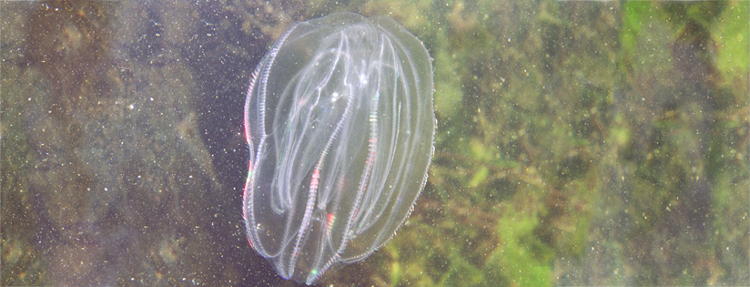
This week we have something commonly called a comb jelly, but more specifically called a ctenophore (silent ‘c,’) because it’s not a jellyfish and in fact pretty far removed from such – it’s in a phylum all its own. I found one by accident in Florida one time, because they’re so completely transparent that I didn’t even spot it when I was sweeping a net through the water after other critters. Later on, I specifically captured one and kept it for a short time in my saltwater aquarium, and that’s the one you see here. You can get a few more details and a slightly better version of the image right here.
While I was pleased to capture the comb jelly, I was much more pleased to capture the refraction iridescence along the rapidly-moving rows of cilia along the body that serve as their means of propulsion. It took standing above the tank shooting straight down into the water when the jelly got near the surface, with the flash unit on a separate stand alongside the tank. I couldn’t get enough distance with the Sigma 105mm macro to have the entire ctenophore in the frame, so I resorted to the Sigma 28-105 instead.
That’s only part one of the story. Part two came several years later when I was contacted by a law firm for photos to use on their website. The most demanding part of their criteria was that they be in ‘banner’ form, a certain set of broad proportions that I really never shot in. The constraints of getting this photo meant that it was actually crowding the frame, so it really couldn’t be cropped down to their dimensions, though I was really proud of the image and figured very few people had any offerings like this.
So, I made it fit their proportions. The version you see here is close to the original frame – it was a little wider, but not anywhere near as wide as that above, which represents their dimensions. To get the one above, I created a much broader field of view along both sides by ‘Photoshopping’ it in. Using the original frame, I did a lot of selective copying, inverting, and general playing around to expand the image size without appearing to be copied, avoiding that ‘repeating pattern’ thing that most people expect. If you look closely along the right side of this image, you can see that some of the brighter green seaweed is reversed and inverted. Various appearances of the suspended sediment within the water, the white spots that would serve as the biggest giveaway about editing, were simply pasted over with darker portions. I’m fairly certain that virtually anyone could only see the evidence of editing if they were specifically looking for it with the knowledge that it existed.
And after all that, they didn’t select this as one of the images to use. Ah well. I was paid for what they did use, so I’m good.
Part three of the story is, having to go through countless images from Florida to see what would work in banner form, I realized that such a cropping method had an interest all its own, and soon afterward I adopted a rotating banner theme for the blog – and it’s been up there ever since.




















































